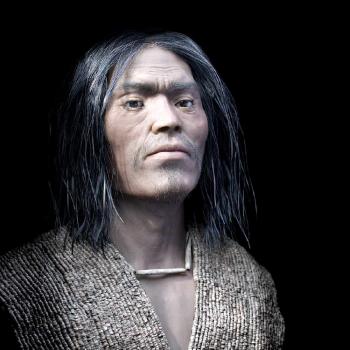Image Caption
Summary
By Andrea Smith
Windspeaker.com Contributor
The Shishalh Nation of B.C. has been given the incredible opportunity to view the faces of their 4,000-year-old ancestors. This is the result of a three-year joint project between the Shishalh Nation and the Canadian Museum of History in Gatineau, Que., which saw the creation of 3-D models based on skeletal remains of a wealthy family unearthed seven years ago.
The models were unveiled May 10 and will be opened for viewing in the Canadian History Hall which opens July 1.
“Here we had these burials, and a very compelling story to tell… And we started very carefully and closely with Shishalh Nation,” said Dr. Matthew Betts, curator of the project at the museum.
“They were extremely helpful. It was their story to tell and they were very excited about it,” he said.
There are also “sister” models, being worked on right now, which will open for viewing at the Tems Swiya Museum in Sechelt July 1st.
According to Betts, the project was made possible because the Shishalh Nation members invited the museum to participate in the excavation of the site the family was found in. As each body was uncovered, the realization that the family involved held a prestigious position within their group, came to light.
“The most impressive find was a man in his 50s, buried with 350,000 stone beads, so really about the size of a bath tub full. And then there was a woman found in her 20s… She was buried with about 15,000 beads—substantially less, but still a significant number,” said Betts.
Because of the “wealth” found with these people, the Shishalh Nation members and the working archaeologists deduced the older male was likely a chief. Each bead would have taken about six-minutes to craft, so the labour involved in making all of them, is what’s really impressive, said Betts.
Betts’ partner on the project, along with the Shishalh Nation, was Terence Clark, an archaeology and anthropology professor at the University of Saskatchewan. Clark’s partner is Gary Coupland, a professor at the University of Toronto. Both Clark and Coupland helped with the excavation, while Betts himself was a key part of the goings-between with the Shishalh Nation and the museum in Quebec.
To reconstruct the faces, the remains of the bodies had to be shipped to the museum. Tissue samples were taken, and other parts of the bodies, such as facial skeletal structures and jaw sizes, were scientifically analyzed. Forensic artist, Philippe Froesche, was hired, and using the scientific data, Froesche created the faces digitally in images so realistic they could be mistaken for photographs, according to Betts.
“This guy is extremely talented… He’s reconstructed faces of queens and kings of France. I thought it was fitting this person who worked on bringing to life kings and queens is now working on powerful leaders of the Shishalh Nation,” he said.
“We sent him the 3D models of the skulls that we scanned and then he digitally added muscles and tissues of the face, and then he added hair and skin tone and facial expressions,” said Betts.
The images were sent to the community for their critique—many times—and Froesche would tweak his work according to the Shishalh input. Sometimes they would give advice on how much of a smile should be on the face of the character in the image, or what length his hair should be. At one point, they felt the hair was just too European looking, said Betts.
“It was a very fun time, and it was really moving to be the first people to be able to see these individuals… for the first time in 4,000 years,” said Betts.
The remains have gone back to the Shishalh Nation for reburial, and it’s up to them to decide exactly how to do it. Newly elected Chief Warren Paull was not involved with the project for much of its duration, but he has spoken with some of the people who were involved, including Keith Julias, who was the person who found the beads when they were just barely sticking out of the ground.
“He found those 350,000 beads that were hand-carved, and all the way around the figures… and the two broken arrow heads found near the bodies. He said it was an awe-inspiring moment. From the look of it, it was a long-standing site, long used for very special individuals… leaders or shamans,” he said.
As for the remains, Chief Paull says their reburial site is yet to be determined. Paull and the Shishalh members want the remains to be buried respectfully, and in a place they won’t be disturbed again. But Paull hopes seeing the faces of these people on display in the museums will send a clear message to visitors.
“It’s the realization that our people have been here since time immemorial… It’s like when you go to Mexico and visit the Mayan ruins. We want to show people we were here just as long as they were…. And our history stretches back that far,” he said.

